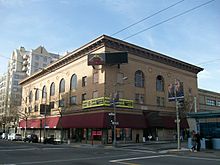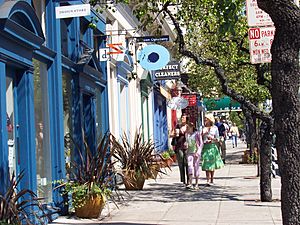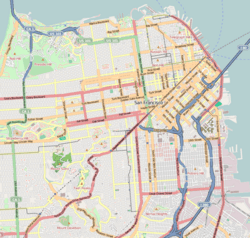Fillmore District, San Francisco facts for kids
Quick facts for kids
Fillmore District
|
|
|---|---|

The Fillmore Auditorium on Fillmore and Geary
|
|
| Nicknames:
The Fillmore, The Moe, Fillmoe, The FeeMoe, Filthy Moe, The Mighty Westside, Harlem of the West
|
|
| Country | |
| State | |
| City and county | San Francisco |
| Named for | Fillmore Street and Millard Fillmore |
| Area | |
| • Total | 0.463 sq mi (1.20 km2) |
| • Land | 0.463 sq mi (1.20 km2) |
| Population
(2008)
|
|
| • Total | 12,934 |
| • Density | 27,919/sq mi (10,780/km2) |
| Time zone | UTC-8 (Pacific) |
| • Summer (DST) | UTC-7 (PDT) |
| ZIP codes |
94102, 94109, 94115, 94117
|
| Area codes | 415/628 |
The Fillmore District is a historic neighborhood in San Francisco. It's southwest of Nob Hill and west of Market Street. People sometimes call it "the Moe" or "the Fill."
This area became important after the 1906 San Francisco earthquake. Since it wasn't badly damaged by the earthquake or the fires, it quickly became a main center for business and culture in the city.
After the earthquake, many different groups of people moved to the Fillmore. Large numbers of African Americans, Japanese, and Jewish people made their homes here. Each group added to the local culture. This made the Fillmore known as one of San Francisco's most diverse neighborhoods. It was especially famous for having the biggest jazz music scene on the West Coast. This lasted until the 1970s. A large Japanese community, called Japantown, was also historically part of the Fillmore District.
In the late 1960s and 1970s, the Fillmore District went through a big rebuilding project. This caused the jazz scene to decline. However, some people say that jazz music has become popular again in recent years. The rebuilding of the Fillmore is still a topic of discussion. Some people who had to move out felt it was unfair. City planners said the changes were needed to improve the area and its economy.
Contents
Exploring the Fillmore District's Location

The exact borders of the Fillmore District are not always clear. It is usually seen as part of the Western Addition neighborhood. Its rough borders are Van Ness Avenue to the east and Divisadero Street to the west. To the north is Geary Boulevard, and to the south is Grove Street.
These borders are not exact. For example, the Westside Housing Projects are considered part of the Fillmore. They are a bit outside these main lines. Fillmore Street, which gives the district its name, is the main road running through the middle.
The area east of Fillmore Street is often called Downtown Fillmore. The area to the west is known by many as Uptown Fillmore. Some older definitions included Hayes Valley, Japantown, and what is now called North of Panhandle. However, new building projects have made these areas more separate.
The northern part of Fillmore Street, north of Geary, used to be called Upper Fillmore. But as property values went up, it became more connected to the wealthy Pacific Heights neighborhood. Now, this area is often called "Lower Pacific Heights." Most locals agree that the Fillmore District has become smaller over the years.
A Look Back at Fillmore's History
The Fillmore District was created in the 1880s. It was meant to provide new space for San Francisco to grow. After the 1906 San Francisco earthquake, Fillmore Street was not badly damaged. It became a major business center while the city's downtown was rebuilt. During this time, many different groups of people moved to the district. These included Jewish, Japanese, and later, African-American communities.
In the 1960s, big redevelopment programs caused many people to move. This also led to a decline in the district's famous jazz and cultural scene.
Jewish Community in the Early 1900s
After the 1906 earthquake, Jewish immigrants from Eastern Europe moved to the Fillmore. Many also came from the SOMA district, which was damaged. Jewish-owned businesses opened on Fillmore and McAllister streets. These businesses served the community.
The district had three synagogues, a Yiddish Cultural Center, and a school. The Fillmore was seen as the main center for the Jewish community in San Francisco in the early 20th century.
Japanese Immigration and Internment History
A large Japanese population has lived in the Fillmore since the 1906 San Francisco earthquake. They created a Japantown that is still close to its original spot today. In 1906, about 5,000 Japanese people lived in this part of town. For a long time, they were the largest minority group in the Fillmore.
Like other ethnic groups in San Francisco, Japanese people faced unfair treatment. Many Americans saw the Japanese as foreigners. They believed Japanese residents were still loyal to Japan, even if they were born in America. This unfair treatment led to the executive order 9066. President Franklin Roosevelt signed this order. It led to the internment of all Japanese citizens during World War II.
After the war, Japanese people slowly moved back to the Fillmore. The Japanese population returned to its pre-war numbers within a few years. A famous Japanese monk, Nyogen Senzaki, opened the first zendo (Zen meditation hall) in the United States in an apartment on Bush Street in the Fillmore.
The African-American Community's Growth
Some African Americans lived in the Fillmore District after the 1906 San Francisco earthquake. But it was not until WWII that the Fillmore and San Francisco saw a big increase in their African-American population. Between 1940 and 1950, the African-American population in San Francisco grew from 4,836 to 43,460. This was from 0.5% to 4.5% of the city's total population. Most of these new residents lived in the Fillmore District.
The Japanese internment in 1942 left many empty homes and businesses in the Fillmore. Also, the shipbuilding industry and wartime economy during WWII created many jobs in the city. Many African Americans also left the South during the Great Migration. They wanted to escape unfair Jim Crow laws.
This large number of African Americans during and after WWII created some tension. Many African Americans were limited to living in certain neighborhoods. The Civil Rights Movement helped African Americans gain important legal rights. However, some social tensions still exist today.
After the war, the African-American population greatly helped the growing jazz culture in the Fillmore. Clubs like Jimbo's Bop City (open from about 1950 to 1965) became very popular. The number of African Americans in the city and district continued to grow. It reached its highest point of about 13 percent in the 1970s.
In the 1970s, the Fillmore District was a main focus of the city's redevelopment efforts. Many people believe that these projects caused the decline of the Fillmore as a center for jazz and African-American culture. Since the redevelopment began in the 1970s, the African-American population in San Francisco has decreased. It went from about 13 percent to just under 6 percent of the total population by 2010.
Redevelopment and Community Changes
After WWII, the city government worried about the Fillmore District. They saw it as an area with poverty that needed big changes. So, the city of San Francisco created the San Francisco Redevelopment Agency (RDA). This agency was in charge of the rebuilding efforts.
The city focused on two main projects: A-1 and A-2. The A-1 project started in 1956 and ended in 1973. It mainly focused on the Japantown side of the Fillmore. Its main feature was the JCTC (Japanese Cultural and Trade Center). This project covered 28 city blocks. It caused about 8,000 people to move and destroyed 6,000 low-rent homes.
The A-2 project began in 1966 and lasted until the late 1970s. This project covered about 70 city blocks around the A-1 area. It caused up to 13,500 residents to move. It also destroyed 4,522 households and 5,000 low-rent homes.
The RDA thought the A-1 project was a big success because it boosted the local economy. However, both projects faced a lot of public opposition. Many people who criticized the projects were those who were forced to leave their homes. The A-2 project, in particular, was seen as harmful to the Fillmore's culture. Many anti-redevelopment groups said it hurt the jazz scene.
The RDA tried to explain its projects. They said that former residents could return after the rebuilding. They also argued that the projects would bring a new economic boom. But both of these statements turned out to be false. The new homes were too expensive for many former residents. They had to move away. Also, the expected economic boom from the A-2 project never happened.
Many people now see the redevelopment of the Fillmore as unsuccessful. It caused many residents and businesses to move. It also had mixed economic effects. The area now has big differences between rich and poor. This is due to new, more expensive housing and the decay of some older, cheaper buildings.
Modern Urban Renewal Efforts
In the 1990s and 2000s, the neighborhood saw another wave of changes. This included a new "Jazz District" along Fillmore Street. It featured mostly fancy jazz-themed restaurants. There were also plans for new apartment buildings.
Fillmore's Economic Role Over Time
After the 1906 earthquake damaged Market Street, many businesses and banks moved to the Fillmore District. For a time, the Fillmore played a key role in San Francisco's economy. But once Market Street was rebuilt, many businesses moved back. The Financial District then became more important economically than the Fillmore.
Key Landmarks and Features in Fillmore
Fillmore Street is the neighborhood's main shopping area. It shows the Fillmore's diverse nature. You can find family-owned shops, chain stores, jazz clubs, and many types of ethnic restaurants. Plaques on the sidewalk remember some of the stores, restaurants, and clubs that were lost during redevelopment.
There is also a branch of the San Francisco public library at Geary and Scott.
The Famous Fillmore Auditorium
The historic Fillmore Auditorium is in the neighborhood. It is at the corner of Geary Boulevard and Fillmore Street. This is a major concert hall known for the psychedelic music scene of the 1960s. Early concerts by bands like Jefferson Airplane and the Grateful Dead took place here.
Jazz and Blues Music Scene
In the 1940s and 1950s, the Fillmore was called the "Harlem of the West." Many famous jazz performers came here. These included Louis Armstrong, John Coltrane, Ella Fitzgerald, Billie Holiday, and Charlie Parker. Fillmore Street had many nightclubs. Jimbo's Bop City is said to be the only place where Parker and Armstrong performed together.
In the 1990s, the San Francisco Redevelopment Agency created the Historic Fillmore Jazz Preservation District. This was to help bring back entertainment and businesses to the area. A Jazz Heritage Center was built within a new apartment and business complex. This complex housed the San Francisco branch of Yoshi's jazz club. Yoshi's SF closed in 2014 and was replaced by The Addition, which closed in 2015.
Many nightclubs, like Leola Kings Bird Cage and Shelton's Blue Mirror, brought major music stars to the neighborhood.
Local Markets and Fun Festivals
A farmer's market is held at the Fillmore Center Plaza every Saturday morning, all year round. The market features local jazz musicians and fresh produce grown in California.
The Fillmore Street Jazz Festival happens every July. The Fillmore Fridays Outdoor Music and Cinema Series takes place on Friday evenings from August to October. The Juneteenth Festival, celebrating the end of slavery for African Americans, is held every June 19.
Getting Around: Public Transit
Because of its central location, the neighborhood is served by several Muni bus lines. These include the 22, 21, 24, 38, 31, 43, 47, 49, and 5.
The Peoples Temple and Its Impact
In 1971, a new religious group called the Peoples Temple set up its main office at 1859 Geary Boulevard. This was on the edge of the Fillmore district. The group's leader, Jim Jones, began sharing his ideas of community and racial equality. This message was well-received by people in the Fillmore. They saw Jones as a hopeful figure during a challenging time after urban renewal.
Jones connected well with the mostly Black churchgoers in the Fillmore. He used the language and traditions of Black churches. This resonated with many of his followers. He also used his charm and persuasive ways to gain the loyalty of many residents.
In 1974, Jim Jones decided to move the Peoples Temple to Guyana. He believed it was the perfect place to build the community he imagined. He also wanted to escape growing pressure from negative news reports in San Francisco. Jones convinced many Fillmore residents to join him. After a year of building their new home, Jones led his followers in a tragic event. This event is known as the Jonestown massacre. 918 people lost their lives. A large number of them were from the Fillmore district.
The former San Francisco headquarters of the Peoples Temple is now a United States Post Office building.


